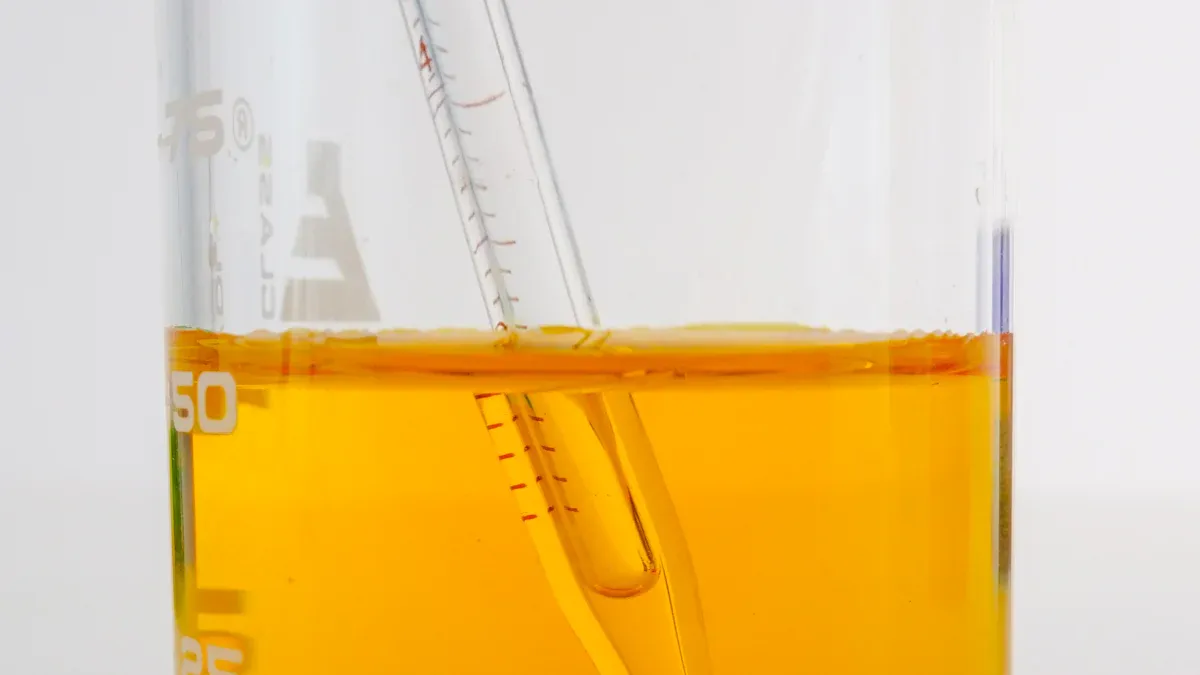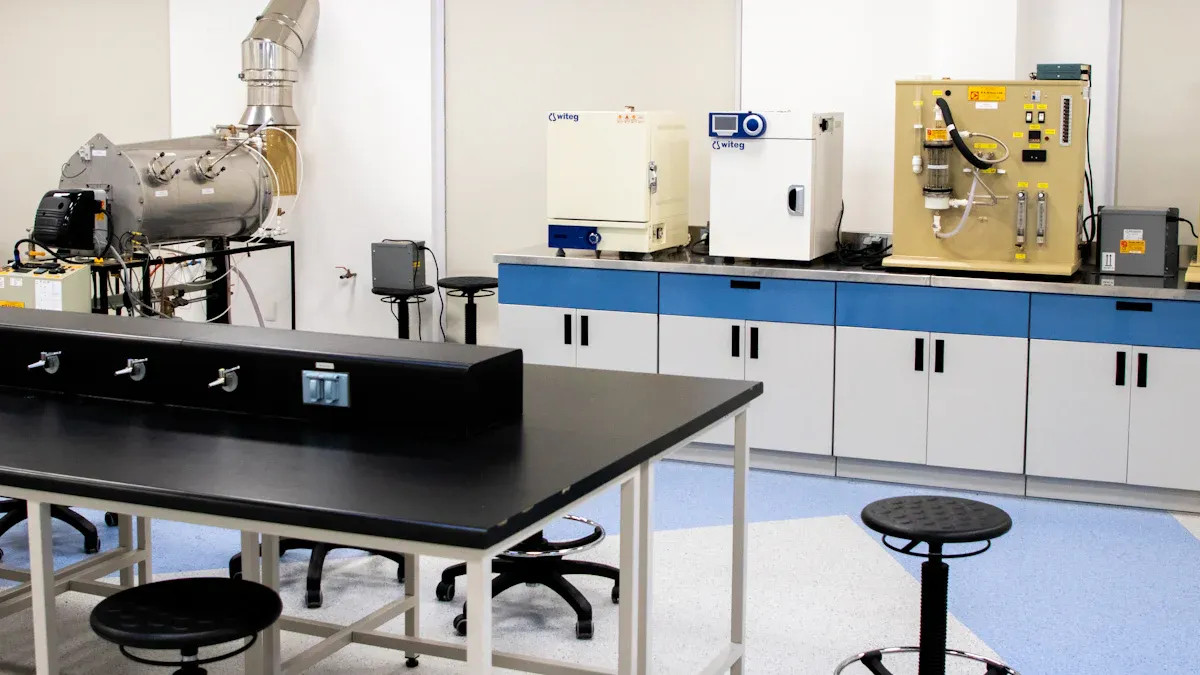
You use an Infared Oil Analyzer to test oil quality quickly and accurately. Following the right steps helps you trust your results every time. FTIR technology in the Infared Oil Analyzer makes testing fast and easy at your location. When you follow each step, you avoid errors and get clear answers. Many maintenance workers use FTIR with an Infared Oil Analyzer for reliable oil testing. The infrared method lets you spot changes in oil quickly, so you can keep machines safe.
Key Takeaways
-
Use an infrared oil analyzer with FTIR technology. It gives fast and accurate oil test results on-site.
-
Prepare your oil sample with care. Use clean tools. Put a drop right on the analyzer’s crystal. Do not add chemicals.
-
Collect oil samples the right way. Use clean containers. Label them clearly. Store them well. This helps avoid contamination.
-
Always calibrate and clean your analyzer before testing. This makes sure results are reliable and consistent.
-
Look at the test results carefully. You can spot oil changes or contamination early. This helps keep your machines safe.
Infrared Oil Analyzer Overview

How Infrared Spectroscopy Works
An infared oil analyzer checks what is in oils and lubricants. The analyzer has a few main parts. These are an infrared light, a sample holder like an ATR crystal, a detector, and a data system. You put the oil sample on the analyzer. The infrared light goes through or bounces off the oil. Chemical bonds in the oil take in certain colors of the light. This makes a special spectrum for each oil sample. The spectrum is like a fingerprint. It shows what is in the oil and if anything has changed.
The analyzer gathers this spectrum and sends it to the data system. You see the results as a graph with high and low points. Each high point matches a certain chemical bond in the oil. This way, you can find problems like contamination or changes in the oil. You can use this method to check for total oil and grease (TOG), fats, oils, and grease (FOG), and total petroleum hydrocarbons (TPH). These things help you watch oil quality and keep machines working well.
FTIR Technology in Oil Analysis
FTIR means Fourier Transform Infrared. People use FTIR in oil analysis because it is quick, correct, and does not hurt the sample. FTIR uses a special way to get the spectrum. This makes it easier to see small changes in oils and lubricants. You do not need to do much to get the sample ready. This saves time and helps stop mistakes.
With FTIR, you can check many things about the oil at once. You can see if the oil has mixed with other things or if it is breaking down. FTIR can find even tiny amounts of other stuff, sometimes as little as 5%. You get a full chemical picture from just one test. This makes FTIR great for checking quality and watching oil condition. The spectrum from FTIR gives you clear answers about the oil. You can make fast choices. FTIR also saves money because you use fewer chemicals and need less training. You can trust FTIR to give good results every time you use your infared oil analyzer for infrared analysis.
Using the Infrared Oil Analyzer

Preparing for Oil Analysis
You need to get ready before you start oil testing. Good preparation helps you get the best results. Start by making sure your infrared oil analyzer is clean and working. Check that the ATR crystal or sample holder is free from old oil or dust. Use a lint-free cloth or the cleaning tool that comes with your analyzer.
Follow these steps to prepare your oil sample for analysis:
-
Take a clean dropper or pipette.
-
Place a single drop of the oil sample directly onto the ATR crystal. You do not need to dilute the oil or add chemicals.
-
Avoid using old methods like pressing oil into pellets or making thin films between salt plates. These are not needed for FTIR-ATR analysis.
-
Use the oil sample as it is. This saves you time and lowers the chance of mistakes.
-
If you work with used engine oils, make sure the sample is well mixed before you take a drop.
Tip: Always use gloves when handling oil samples. This keeps your hands clean and stops you from adding contaminants to the oil.
Collecting Oil Samples
You must collect oil samples with care. The way you collect the sample affects your analysis and the data you get. Use clean bottles or vials made for oil testing. Never use containers that held other oils or chemicals.
Here are some best practices for collecting oil samples:
-
Clean all tools and containers before use.
-
Avoid touching the inside of the bottle or the sample with your hands.
-
Label each sample with the date, machine name, and type of oil.
-
Store the oil sample in a cool, dry place until you are ready for analysis.
-
For used oil, take the sample from the middle of the oil stream, not from the top or bottom. This gives you a true picture of the oil condition.
Note: Poor cleaning, dirty tools, or bad storage can add contaminants to your oil sample. This can change your results and make your oil analysis program less reliable.
Running the Analysis
Now you are ready to run the analysis. Turn on your infrared oil analyzer and let it warm up if needed. Follow the steps on the screen or in the manual.
-
Place the oil sample on the ATR crystal or in the sample holder.
-
Close the cover if your analyzer has one.
-
Start the analysis by pressing the correct button or using the touchscreen.
-
Wait for the analyzer to scan the oil. This usually takes only a few minutes.
-
The analyzer will show a spectrum on the screen. This is your data.
If you test used engine oils, repeat the process for each sample. Clean the ATR crystal between samples to avoid mixing oils.
Tip: Always check that the analyzer is calibrated before testing. Calibration helps you get accurate results every time.
Interpreting Results
After the analysis, you will see a graph or spectrum. This shows how the oil sample absorbs infrared light. Each peak on the graph matches a chemical bond in the oil. You can use this data to find out if the oil has changed or if it has picked up contaminants.
Look for these things in your results:
-
Peaks that show water, fuel, or other contaminants in the oil.
-
Changes in the base oil, like oxidation or breakdown.
-
Signs of wear metals or additives in used engine oils.
Compare your results to past data from your oil analysis program. This helps you spot trends and make good choices about machine care. If you see big changes in the oil, you may need to change the oil or check the machine for problems.
Remember: Good data and careful analysis help you keep your machines safe and running well. Used oil analysis gives you early warnings about problems.
You can also export the analytical results to a computer or cloud system. This lets you track oil samples over time and share data with your team.
Key Features for Accurate Infrared Analysis
Calibration and Sensitivity
You must have good calibration to trust your results. Infrared oil analyzers use automatic reference calibration. This checks the device before every test. You do not need to change settings yourself. The analyzer watches the wavelength and keeps the spectrum clear. High sensitivity helps you notice small changes in oil quality. You can see tiny amounts of water, fuel, or other contaminants. The analyzer shows these changes in the spectrum. You get the data right away. Good calibration and sensitivity help you watch oil condition and keep your machines safe.
Portability and Ease of Use
You want an analyzer that is light and simple to use. Many infrared oil analyzers are small and easy to move. You can take them from one place to another. USB lets you move data fast. The software is easy to understand. You start tests with just a few steps. Fill the cuvette, put it on the platform, and press start. You do not need to do anything special to the oil sample. This saves time and keeps the sample safe. The analyzer records the room temperature and humidity. These features help you get good data and keep oil quality high.
Tip: Pick an analyzer with real-time monitoring. This helps you get the best data and set up the test right.
Rapid Measurement and Data Management
Fast testing is important for busy teams. Infrared oil analyzers can check oil quality in about one minute. You get the spectrum and data almost right away. The analyzer saves all data for each test. You can send results to a computer or cloud system. This makes it easy to watch oil samples over time. You can compare data and see changes in oil quality. Good data management helps you make smart choices about machine care. You keep your records neat and make your oil analysis program better.
| Feature | Benefit |
|---|---|
| Rapid measurement | Saves time, boosts efficiency |
| Easy data export | Tracks oil quality over time |
| Automatic calibration | Ensures accurate spectrum |
Best Practices for Reliable Oil Testing
Maintenance and Calibration
You need to take care of your infrared oil analyzer. Clean the ATR crystal after each oil sample. This stops old oil from changing your results. Calibrate your analyzer before you start testing. This helps you get the right readings for oil quality. You should also check for software updates on your device. New software can help you find small changes in used oil. Use the same steps every time you do maintenance. This keeps your oil analysis results steady and correct. Training teaches you how to handle oil samples and care for your analyzer. These steps help you trust your oil test results.
Sample Handling Tips
You must be careful with every oil sample. This helps you avoid contamination and get real results. Here are some tips for handling oil samples:
-
Take an oil sample that shows the true condition of your equipment. Use the right steps so your sample is accurate.
-
Stop air from getting in when you collect the sample. This is very important for transformers under vacuum.
-
Flush the sampling valve with about two liters of oil first. This gets rid of dirt or old oil in the valve.
-
Always use clean bottles or vials for each sample. Do not use bottles that had other oils or chemicals before.
-
Write the date, machine name, and oil type on each sample. Keep samples in a cool, dry place until you test them.
These tips help you keep your oil samples clean and your data correct.
Avoiding Common Mistakes
You can get better oil test results by not making common mistakes. Do not forget to calibrate or clean your analyzer. Always mix used oil samples before you test them. This gives you a true look at the oil. Do not take oil from the top or bottom of the oil stream. Take it from the middle for the best sample. Use your oil test results to help make maintenance choices. This helps you fix problems before they get worse. Studies show that following these tips makes machines last longer and saves money. You keep your machines safe and oil quality high by avoiding mistakes. Watch for signs of oil oxidation and oil breakdown in your results. These signs help you act fast and stop damage.
You can achieve accurate oil testing by following each step with your infrared oil analyzer. FTIR helps you spot changes in oil quickly and keeps your machines safe. When you use FTIR, you get fast, clear results and avoid mistakes.
-
These steps help you stay safe, follow standards, and keep your equipment working well.
-
FTIR lets you test oil on-site, save money, and protect the environment.
-
Many teams see longer oil life and fewer accidents when they use FTIR for regular checks.
Start using FTIR in your routine maintenance to keep your machines running and your team safe.
FAQ
How often should you calibrate your infrared oil analyzer?
You need to calibrate your analyzer before every test session. This helps you get the right results each time. Some analyzers can calibrate themselves, which makes things easier for you.
Can you test different types of oil with the same analyzer?
Yes, you can use one analyzer for many oil types. Make sure to clean the sample holder after every test. This stops oils from mixing and keeps your results correct.
Tip: Always put a label on each sample so you do not mix them up.
What should you do if you see unexpected peaks in your spectrum?
If you see strange peaks, it could mean the oil is dirty or has changed. Look at your sample for dirt or water. Clean your analyzer and try the test again if you need to.
Is FTIR oil analysis safe for the environment?
FTIR oil analysis uses less chemicals and makes less waste. This helps keep the environment safe. You also do not need to use as many dangerous solvents.
https://www.schinstrument.com/infrared-oil-analyzer-accurate-oil-testing-ftir-features.html